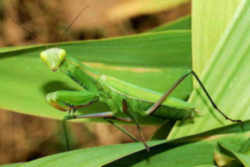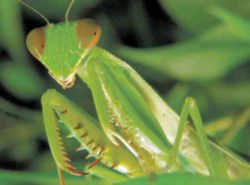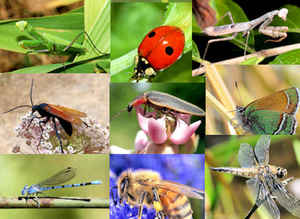
Connecticut Symbols
Connecticut State Insect
Praying Mantis

(Mantis religiosa)
Adopted in 1977.
The Praying Mantis, (Mantis religiosa,) was adopted in 1977 as Connecticut's state insect. The name "mantis" (derived from
the Greek word for "prophet" or "diviner") appropriately described the mantis' distinctive habit of standing motionless on four hind legs, with the
two highly specialized forelegs raised in an attitude of meditation.
Connecticut State Insect: Praying Mantis

The European mantis is not native to Connecticut. It originated in Northern Africa, Southern Europe, and temperate areas of Asia. These mantis can be found, however, throughout the state from early May or June until the cold weather sets in, when they die rapidly.
The praying mantids, or praying mantises, are carnivorous insects that belong to the family. There are about 2,000 species of mantids. The biggest praying mantises are the Tenodera and the Archimantis, which are six inches long! The smallest praying mantis is the Bolbe pygmaea, which is only 2/5 of an inch, or one-centimeter. Unbelievably, some scientists agree the mantis is closely related to the cockroach. The name "mantis" comes from the Greek word for 'prophet' or 'soothsayer.' The Carolina mantid is a common insect of Eastern United States. The European and Chinese species were introduced to the Northeastern United States about 75 years ago as garden predators in hopes of overtaking the native pest population.
Characteristics of the Praying Mantis
Harmless to humans, and averaging 2-2 1/2 inches in length, this small green or brown insect feeds on aphids, flies, grasshoppers, small caterpillars and moths. Although probably not a significant factor in biological control, mantis are beneficial insects for farmers and are therefore symbolic reminders of the importance of the natural environment to human and biological survival.
Camouflage is very important for the praying mantis' survival. Because they have so many enemies such as birds, they must blend in with their habitat to avoid being eaten. They have a triangular-shaped head with a large compound eye on each side. Praying mantids are the only insect that turn from side to side in a full 180-degree angle. Their eyes are sensitive to the slightest movement up to 60 feet away. They have straight, leathery forewings and very powerful jaws used for devouring its prey. They have ultrasound ears on their Metathoraxes. The Metathorax is located on the thorax. Also, the males' genitalia are asymmetrical. They have a long prothorax and strong, spiny front legs held together in a praying manner. In the bodies of some species of mantis, there is a hollow chamber. Recently it has been discovered that these hollow chambers provide the mantis with a means of detecting bats, one of their most feared predators. Apparently, the mantis in flight will drastically change its flight pattern (often hurling to the ground in a spiral) when the mantis hears certain frequencies of sound.
Connecticut General Statutes
The law designating the praying mantis as the official Connecticut state insect is found in the The General Statutes of Connecticut, Title 3, Chapter 3, Section 3-109b.
2012 Connecticut General Statutes
Title 3 - State Elective Officers
Chapter 33 - Secretary
Section 3-109b - State insect. Universal Citation: CT Gen Stat § 3-109b (2012)
The praying mantis, Mantis religiosa, shall be the state insect.
(P.A. 77-243.)
Taxonomic Hierarchy: Praying Mantis
Kingdom: Animalia (Animals)
Phylum: Arthropoda (Arthropods)
Subphylum: Hexapoda (Hexapods)
Class: Insecta (Insects)
Order: Mantodea (Mantids)
Family: Mantidae
Genus: Mantis
Species; religiosa (European Mantis)
Butterflies, and Bugs







